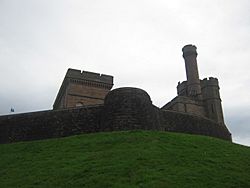Siege of Inverness (1649) facts for kids
Quick facts for kids Siege of Inverness (1649) |
|||||||
|---|---|---|---|---|---|---|---|
| Part of Wars of the Three Kingdoms (Scottish Civil War) | |||||||
 Inverness Castle in modern times. Some of the old curtain wall can be seen in the foreground, while the castle building itself was rebuilt in 1836 |
|||||||
|
|||||||
| Belligerents | |||||||
|
|
|||||||
| Commanders and leaders | |||||||
| Strength | |||||||
| unknown | unknown | ||||||
| Casualties and losses | |||||||
| unknown | unknown | ||||||
The Siege of Inverness in 1649 was a key event during the 17th-century Scottish Civil War. This conflict was part of a larger series of battles known as the Wars of the Three Kingdoms, which affected Scotland, England, and Ireland.
In 1649, after the previous king, Charles I, had died, his son Charles II was declared the new king. Charles II and his supporters, who were living in other countries, wanted to take back control of the kingdom. They planned to work with James Graham, 1st Marquess of Montrose, a famous Royalist leader.
Contents
The Royalist Uprising in Scotland
To help Charles II, a group of Royalist clans in northern Scotland started an uprising. This group was led by Colonel Hugh Fraser. He was joined by other important clan leaders, including John Munro of Lemlair, Thomas Mackenzie of Pluscarden, and Sir Thomas Urquhart of Cromarty.
Capturing Inverness Castle
On February 22, 1649, these Royalist clans marched into the town of Inverness. They quickly took over Inverness Castle, forcing out the soldiers who were guarding it. After capturing the castle, they tore down parts of the town's walls and defenses.
Just a few days later, on February 26, the clan leaders held a meeting. They decided to take control of the taxes and trade income from six northern Scottish areas. This showed they were serious about supporting King Charles II.
Covenanters Respond
The Scottish Parliament, which supported the Covenanters, quickly reacted. They sent General David Leslie, Lord Newark, a skilled military leader, north to stop the Royalist clans.
When General Leslie's army approached, the clans decided to leave Inverness. They retreated to Ross-shire, an area north of Inverness. General Leslie then placed his own soldiers in Castle Chanonry of Ross. He also managed to make peace agreements with most of the clans. However, the Mackenzies did not agree to surrender.
Soon after General Leslie left to go south, the Mackenzies launched a surprise attack. They successfully recaptured Castle Chanonry of Ross.
Clan Loyalty and Shifting Sides
Historians have studied why different clans joined or left the Royalist side during this time.
The Munros and Rosses
According to R.W. Munro, a historian for the Clan Munro Association, General Leslie was very good at talking to people. He was able to convince the Munros and the Rosses to leave the Royalist side. These clans might have joined the uprising mainly to protect themselves. There were rumors that Parliament planned to arrest their leaders.
The Munros and Rosses then fully switched their support to the Covenanters. They even fought alongside the Covenanters at the Battle of Carbisdale in 1650. This battle was against Montrose, the Royalist leader.
The Mackenzies' Actions
The Mackenzies did not fight with Montrose at the Battle of Carbisdale. However, they did communicate with him. They talked to Montrose before the battle and even after he was captured. This shows their continued, though cautious, support for the Royalist cause.
Aftermath and Consequences
After the siege, some people who had helped the Royalists were questioned.
Local Leaders Questioned
Alfred John Lawrence, another historian, explains that the Presbytery acted like a court. They looked into cases where people had broken their Covenant Oath. This oath was a promise to support the Covenanters.
Several local leaders, including Alexander and John Bane of Knockbain, Alexander Bane of Tulloch, Captain Bane of Brahan, and Alexander Bane of Tarradale, admitted they had helped capture Inverness and tear down its walls. They said they had followed Lord Reay and Thomas Mackenzie of Pluscarden in supporting King Charles.
The court accepted that these men had been forced or tricked into joining. They were allowed to go free after promising not to fight against Parliament again.

